2022 Crypto Market Recap Pt. 2: Market Environment Analysis
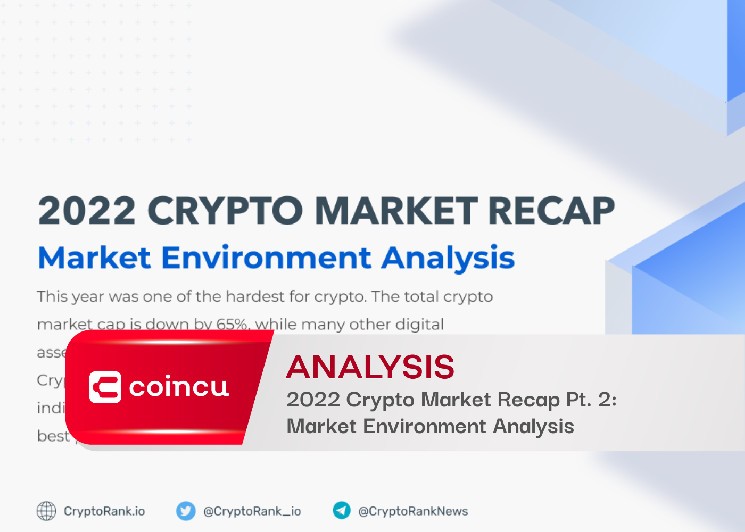
Key Recap Topics:
- Annual market performance.
- The decline of token sale activity
- The state of DeFi
- The adoption of blockchains continues to growth
- The NFT market is in decline
- Challenges confront crypto exchanges.
2022 was a year of disappointments and occasional positivity. In the first part of our Annual Recap, we reviewed the major events of the year, both positive and negative.
Several macroeconomic factors impacted the market this year, including rising inflation and higher interest rates. Traditional financial markets have also shown a strong decline this year. As usually, risky assets (e.g. tech stocks) performed worse. The cryptocurrency market closely followed the stock market for most of the year, with the exception of a few collapses when prices fell dramatically.
In the second part of CryptoRank’s Annual Recap, we analyze the main indicators of the market, their changes, as well as the leaders of individual categories.
2022 Market Performance
The annual returns on the crypto market are quite disappointing. According to the data from CryptoRank.io, the market capitalization has declined by almost 65% — from $2.34T on Jan. 1, 2022 to just $829B on Dec. 31, 2022. During the same period, Bitcoin fell by 64.3%, Ethereum showed a slightly worse performance, down by 67.5%, while most of the market fell by 90% or more. Although the crypto market has had a tough year, it does not mean it is over yet.
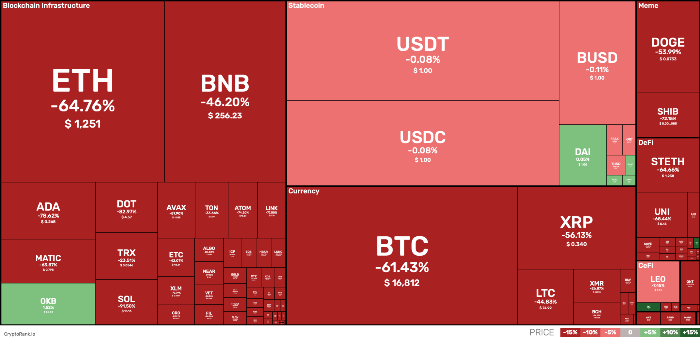
1Y performance as of Jan 5, 2023. Data Source: https://cryptorank.io/heatmaps
Gold was one of the best-performing assets this year, showing just a 1% of return. There has been a decline of approximately 20–30% in riskier assets, bonds, and the S&P500 and Nasdaq indices in 2022 Bitcoin has declined even more, but many tech stocks have fared much worse.
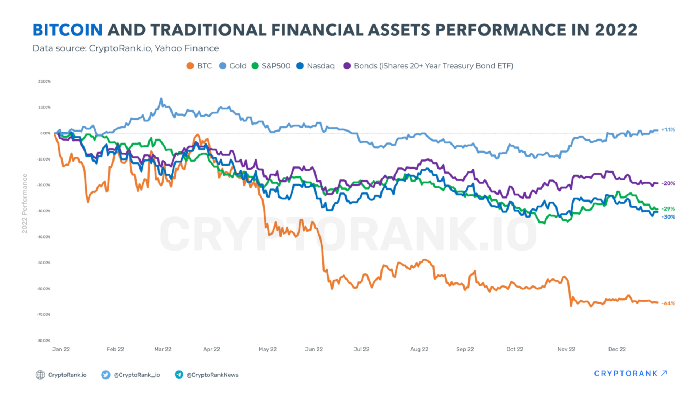
This year, the crypto market has been impacted by many negative factors, which we detailed in Part 1 of our annual recap. The biggest market declines came from FTX Insolvency, the Liquidity crisis of Celsius and Three Arrows Capital, Terra collapse, and Fed Rate hikes.
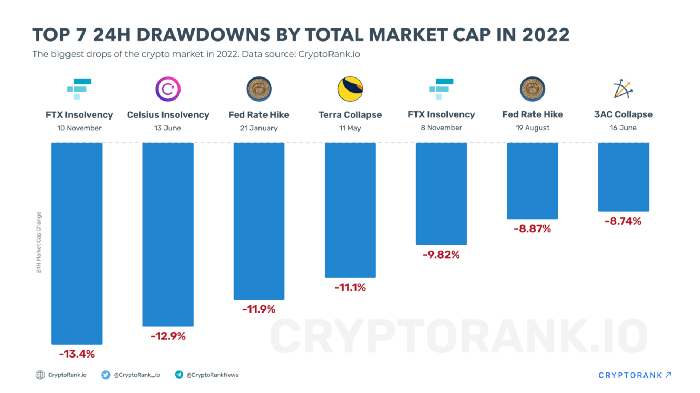
Data Source: https://cryptorank.io/performance
The list of market leaders has also changed over the year. “Some of the prominent projects have left the top 15, such as Solana (which has been affected by the FTX collapse), Terra, Avalanche, Cronos, and Shiba Inu. However, there were new additions to the list of top coins last year such as Binance USD, OKB, Dai, TRON, and Litecoin. Bitcoin and Ethereum have consistently ranked first and second in market capitalization. Stablecoins’ dominance has also increased significantly (from ~6% to ~15.5%), particularly due to the growth of USDC and BUSD supply. This suggests that a considerable part of the capital has not left the market, but is awaiting in more secure digital assets, stablecoin.

Data Source: https://cryptorank.io/all-coins-list
Bitcoin had a challenging previous year. BTC suffered a 37.9% decrease in June 2022, making it the worst month of the year. Bitcoin had closed only four months in the green zone, but the returns were quite low even compared to 2018.
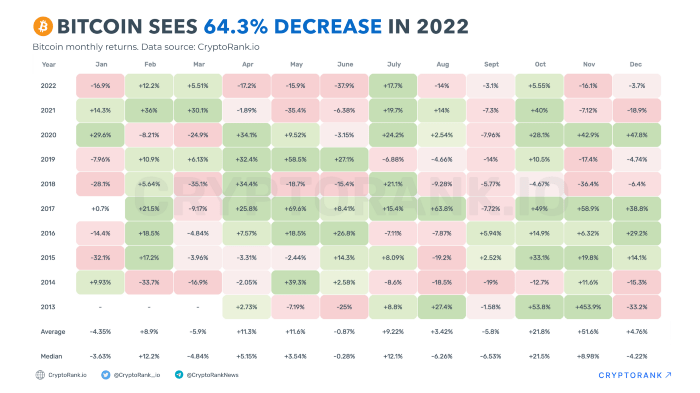
Data Source: https://cryptorank.io/price/bitcoin
Due to a significant downward move, Bitcoin closed the Q2, 2022 with a 56.7% price decline. This is Bitcoin’s worst quarterly performance in more than a decade.
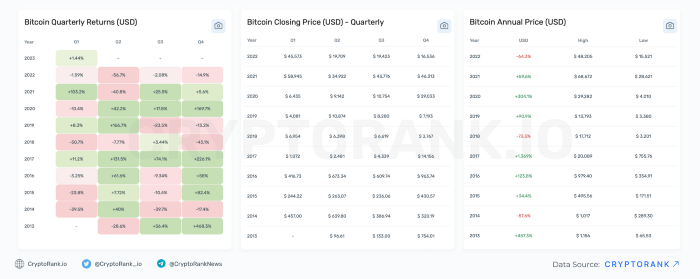
Data Source: https://cryptorank.io/price/bitcoin
It wasn’t all negative, though, as 2022 also featured some gainers. While the list is quite small, let’s check the top 10 gainers of 2022 with a market cap above $5 million and 24-hour trading volume above $200k.
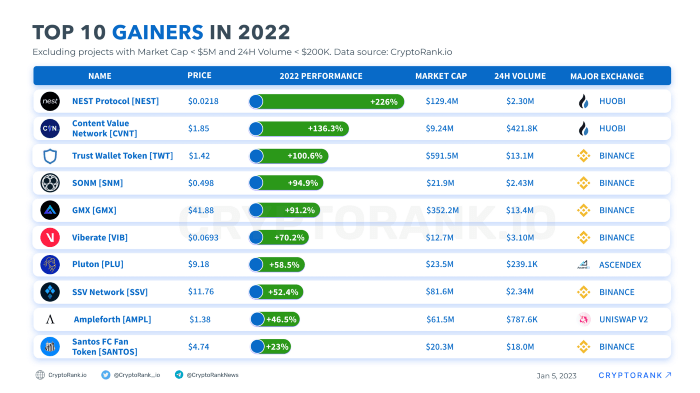
Data Source: https://cryptorank.io/gainers
The decline of token sale activity
The year 2022 has had a strong impact on token sales. In 2021, we have seen the euphoria of IDOs, IEOs, and ICOs. Almost every project in that year showed strong returns, but everything changed drastically with the start of the bear market.
However, pessimism in the markets hit token sales activity on two sides in 2022. On the one hand, users were less risk averse, so they and conduct more research select projects more carefully. On the other hand, many projects possibly realized the inability to raise money at high valuations and avoided entering the market until better times. Therefore, we saw a strong decline at the beginning of the year, which turned into stagnation later.
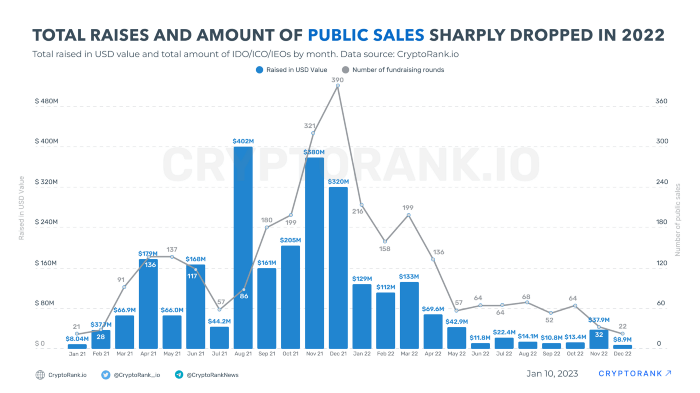
Data Source: https://cryptorank.io/ico-analytics
Speaking of launchpads, it’s much worse. Few launchpads successfully performed in 2022. Even the most stable and reliable ones were forced to reduce the number of token sales. Most of this year’s token sales have been unprofitable, which has hurt the profitability of the launchpads as well.
A notable trend is the raised interest in IEO throughout the year, as their dominance by the number of sales increased. A number of leaders in IEO launchpads emerged during this period. This includes Binance Launchpad, Huobi Primelist, Bybit Launchpad, KuCoin Spotlight, and Gate.io Startup. Perhaps one reason is the high trust in centralized institutions (which was relatively high before the FTX collapse). However, during the same period, many IDO launchpads demonstrated unreliability after their ROI dropped along with the market decline.
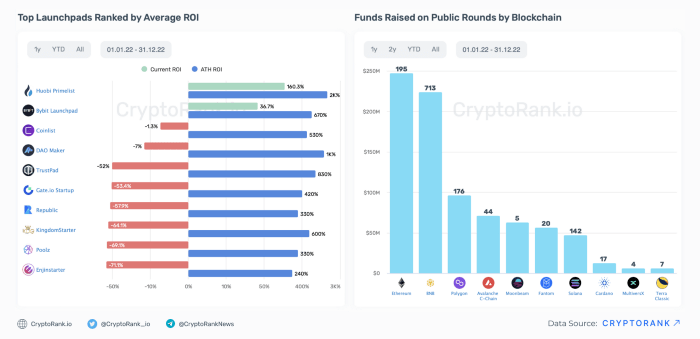
Data Source: https://cryptorank.io/ico-analytics
Even the best launchpads have lost substantially in market capitalization. The price of their tokens fell ~80% over the year and 95%+ from the ATH (which was around the end of October to the beginning of November 2021). Though that’s not the end for launchpads. Right now, some token seals are still generating returns, and some of the launchpads have the potential to grow into something bigger by building a full-fledged DeFi ecosystem.

Data Source: https://cryptorank.io/tags/launchpad
The number of projects that had a positive ROI by the end of the year is extremely small, similar to the list of gainers. Many projects that came out at the beginning of the year were able to show good ATH ROI, but later it fell dramatically. It is worth noting the leader — STEPN, Move To Earn project, whose phenomenon we covered in detail in the first part of the recap. The Move to Earn craze began with STEPN, and dozens of similar projects appeared, mostly poorly made copies. However, only a few of them managed to survive on the market and bring something of value to users. This suggests that truly innovative projects are quite capable of surviving bad times. But at the moment, the fate of STEPN and other successful projects of the past year is not clear.
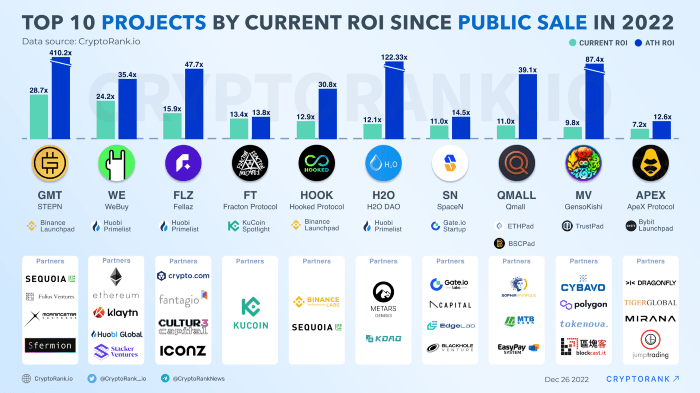
Data Source: https://cryptorank.io/ico
Token sales are struggling globally, but they may improve in the future. In 2022, there were far fewer scam projects that raised money and disappeared and less incompetent teams bringing raw projects to market.
Most importantly, investors became smarter after losing money the previous year. We saw a similar thing in 2018, when the market, oversaturated with bad projects after the 2017 ICO boom, plummeted. A few years later, ICOs have become more transparent and of higher quality, and good projects have successfully survived and thrived.
The state of DeFi
The year 2022 was a challenging one for DeFi. Since the beginning of the year, TVL has decreased by almost four times: from $300 billion to $70 billion. However, the real decline began after the Terra collapse and didn’t stop there. Every exploit that happened during that year was very damaging, not only to TVL but also to DeFi’s reputation.
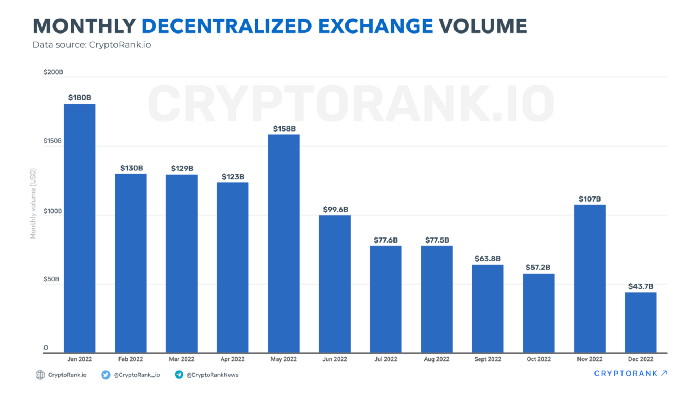
Most networks showed a decrease in TVL at the end of the year. Tron and Optimism are the only ones among the major blockchains that showed TVL growth. Avalanche and Solana experienced the most substantial decline among the top 10.
Ethereum still accounts for more than 60% of the total value locked. Additionally, Layer 2 blockchains have also gained dominance, with Optimism’s TVL almost doubling while Arbitrum’s showing only a small decline.
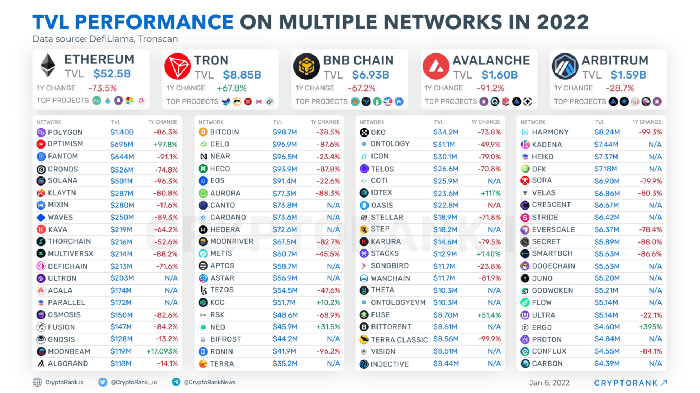
Last year, not many projects showed a decent growth of TVL, but there were significantly more tokens with a rising price. Mostly these are decentralized exchanges (in particular derivatives exchanges) and lending protocols.
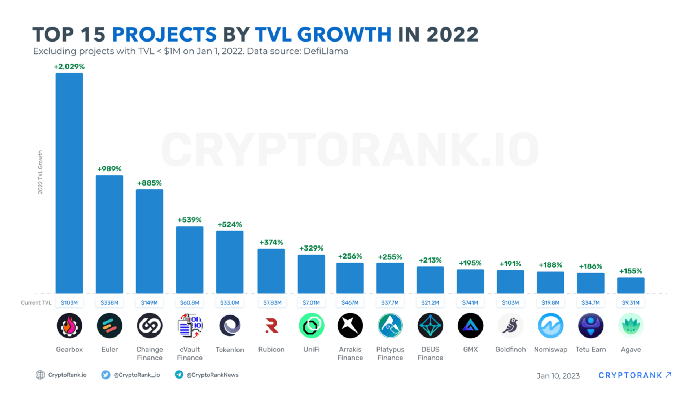
While more web2.5 (active users of exchanges and other centralized crypto companies) users have turned to DeFi since the collapse of FTX, this segment still has a long way to go to become more user-friendly.
Projects will have to work hard on security and user experience to make a truly reliable and user-friendly product. Only then it will be possible to talk about a real adoption of web3.
Blockchain adoption continues to growth
2022 was an important year in the adoption of crypto. BNB Chain surpassed Ethereum in the total number of addresses. Fantom (its data seems quite suspicious), Near, Flow, and Arbitrum showed the highest growth of unique addresses in 2022.
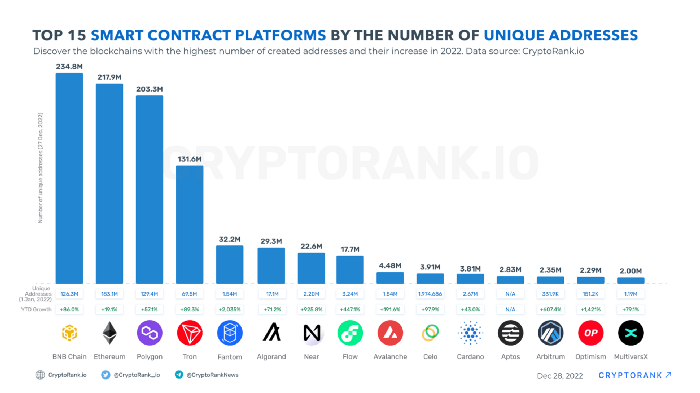
Data Source: https://cryptorank.io/tags/smart-contract-platform
Bitcoin miners’ earnings have fallen dramatically in 2022 as a result of the decline in the price of BTC, raising energy prices, etc. It is worth noting that many Bitcoin miners are currently experiencing serious problems due to high inflation. Some have been forced to declare bankruptcy, and others are on the verge of bankruptcy.
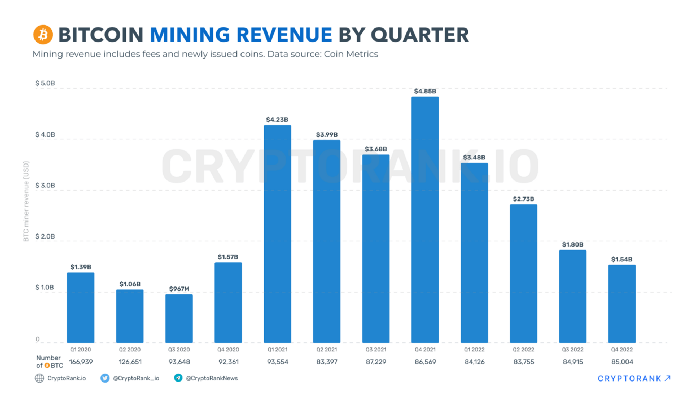
NFT market is on the decline
In 2021, we saw a real boom in the NFT market. The volume of trading on OpenSea on Ethereum reached an all-time high in January 2022, but from then on it gradually declined. By November, trading volumes had reached their lowest level since June 2021.
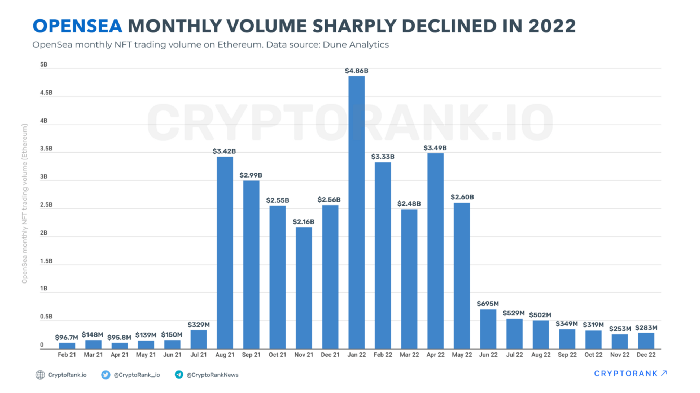
The price of many NFT collections has fallen by 70% or more, as has their liquidity. Despite this, large NFT projects are still going strong. Many collections have garnered record investments from major funds, particularly Yuga Labs, Doodles, VeeFriends, and others. Infrastructure projects, particularly NFT marketplaces, were even more popular among investors.
NFT technology finds its application in DeFi. The use of NFTs as collateral has helped NFT lending projects gain popularity this year. Even though they are not popular yet, it proves that NFTs can be used outside of trading and collecting.
Web3 is largely driven by the adoption of NFT technology by big businesses, such as Starbucks, Disney, etc. Big brands are eager to interact and release their NFT collections, often giving them useful features.
Exchanges face problems
For centralized exchanges, this year is also a period of decline. Despite high volatility, trading volumes have fallen sharply, especially in the last quarter of 2022. However, the decline in trading volumes is not so significant as other problems of centralized exchanges, which were revealed after the collapse of FTX.
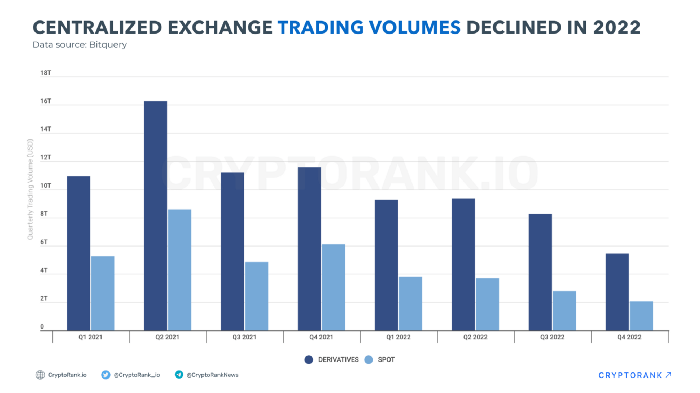
Data Source: https://cryptorank.io/exchanges
The centralized exchanges now have an image of being unsafe after the FTX collapse. Nevertheless exchanges like Binance, OKX, Crypto.com and others published Proof of Reserves to improve transparency and reputation. You can check the CEX transparency dashboard on CryptoRank.io.
Decentralized exchanges are no exception to this trend. During the year, monthly trading volumes on them declined even faster than on centralized exchanges. The exceptions to the trend were May when Terra collapsed, and November, when the FTX collapse caused users to believe in decentralization again.

Data Source: https://cryptorank.io/exchanges/dex
To reverse this trend, decentralized exchanges need to solve several problems, including increasing security and simplifying operations for inexperienced users. At the moment, the share of trading volumes of decentralized exchanges is extremely small compared to centralized exchanges.
The Bottom Line
As 2022 came to an end, fears have not diminished. There are many problems left from last year that have not yet been solved and are just waiting for their moment. One of the biggest questions hanging in the air is the fate of DCG amid the problems of Genesis and Grayscale. The fall of such a large fund could be even louder than the collapse of Terra, 3AC, or FTX.
A year of global financial market collapse was not catastrophic for crypto, despite the significant decline. However, it greatly impacted the industry and stimulated the start of global changes necessary for further development. For now, the market continues to move cyclically, and it is possible that soon, we will start to see stable positive movements.






 Bitcoin
Bitcoin  Ethereum
Ethereum  Tether
Tether  USDC
USDC  TRON
TRON  Dogecoin
Dogecoin  Cardano
Cardano  Bitcoin Cash
Bitcoin Cash  Chainlink
Chainlink  LEO Token
LEO Token  Stellar
Stellar  Litecoin
Litecoin  Hedera
Hedera  Monero
Monero  Dai
Dai  OKB
OKB  Cronos
Cronos  Ethereum Classic
Ethereum Classic  VeChain
VeChain  Cosmos Hub
Cosmos Hub  Gate
Gate  Algorand
Algorand  KuCoin
KuCoin  Stacks
Stacks  Tether Gold
Tether Gold  Theta Network
Theta Network  Zcash
Zcash  IOTA
IOTA  Tezos
Tezos  TrueUSD
TrueUSD  NEO
NEO  Polygon
Polygon  Ravencoin
Ravencoin  Decred
Decred  Dash
Dash  Zilliqa
Zilliqa  Qtum
Qtum  Synthetix Network
Synthetix Network  0x Protocol
0x Protocol  Basic Attention
Basic Attention  Status
Status  Siacoin
Siacoin  Holo
Holo  DigiByte
DigiByte  Enjin Coin
Enjin Coin  Nano
Nano  Ontology
Ontology  Waves
Waves  Hive
Hive  Lisk
Lisk  Pax Dollar
Pax Dollar  Steem
Steem  Numeraire
Numeraire  BUSD
BUSD  NEM
NEM  Huobi
Huobi  OMG Network
OMG Network  Bitcoin Gold
Bitcoin Gold  Ren
Ren  Bitcoin Diamond
Bitcoin Diamond  Augur
Augur  HUSD
HUSD